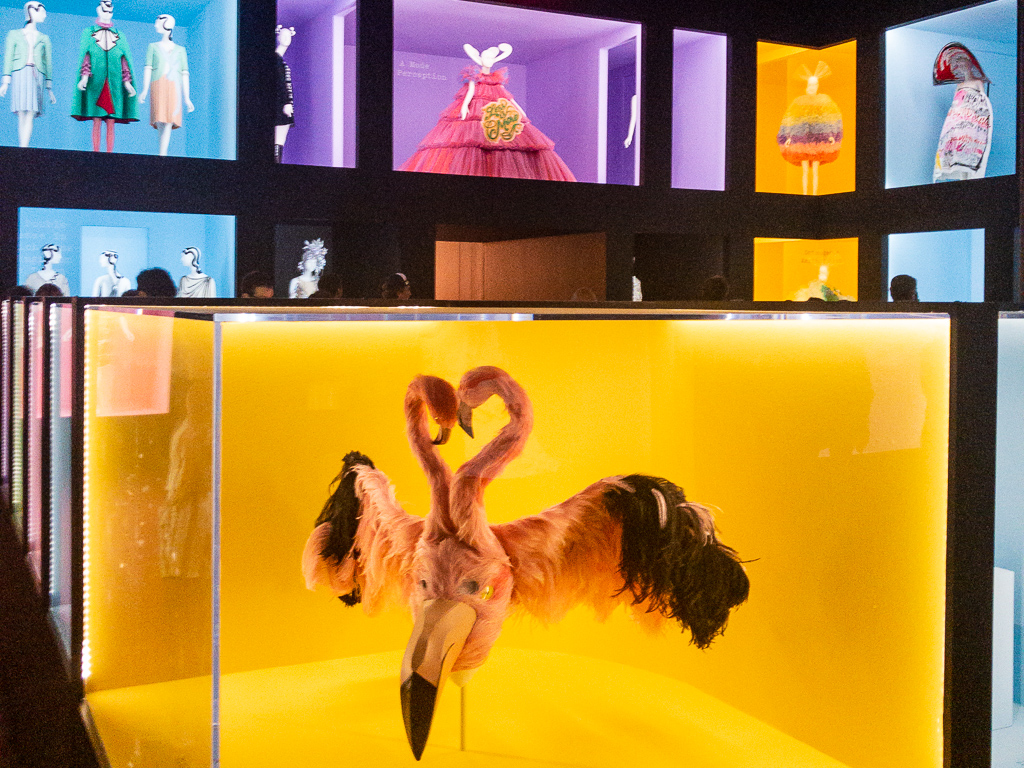The Costume Institute always displays an array of thought-provoking textile pieces that dazzle and amaze me. I love the intermingling of art and fashion and the influence that art directly has had, and continues to have, on fashion. The Camp: Notes on Fashion exhibit was no exception.
One should either be a work of art, or wear a work of art.
Oscar Wilde

I wasn’t sure what to expect when I walked into this exhibit. I have attended other recent Met fashion exhibits, and have consistently been in awe at how they present each theme from a unique, often unexpected, perspective.
But was the camp theme really worthy of an entire exhibit? I was about to find out.
I knew that “camp,” as a noun, adjective or verb, is defined as an exaggerated interpretation of an otherwise traditional item of clothing or decor. And the pieces are often a reflection of pop culture trends.
(Did you notice one of the dresses is actually upside down in the picture to the left?)
If that all sounds vague, it should. What I learned is that the definition of camp is similar to the definition of the Danish word “hygge.” It is undefinable, but undeniable when you see or feel it.
Dissecting Camp: How to Recognize a Campy Piece
Inspired by Susan Sontag’s Notes on Camp, the Met exhibit started with a detailed introduction to the phenomenon of camp. I was anticipating sensory overload. And this is exactly what I felt the curator played on throughout the exhibit, even if it was lacking in the first part of the exhibit.
Each glass case explained a different iteration of camp through the times. It was text-heavy, and felt a bit flat to see the pieces displayed alongside their traditional or pop culture counterpart. But rather than being disappointed, I was captivated by the atmosphere it was creating.




Timeline of Camp | photos from the introduction halls of the Camp: Notes on Fashion exhibit
After letting go of my initial expectations, I found myself enthralled by the attention to detail displayed all around me. It soon became clear that camp has been an important aspect of art and fashion for a long time, dating back much farther than Sontag’s now-famous essay.
I continued to follow the path of the exhibit and read the meticulously detailed explanations about camp and its history. With each new piece of camp introduced, I got a strong sense that this was building up to something much bigger than what was right in front of me.
Surprise! This Was Not Your Typical Met Fashion Exhibit
I expected to be wandering through room after room showing how camp fashion was inspired by art throughout the times, but I was wrong! That was not the point of this exhibit, they had something else in mind.
What is the point? And what exactly is camp?
For me, the exhibit made it clear that the curator wanted us to see that camp was both inspired by the people who created the designs and those who wore the pieces. What intrigued me the most was the fact that how the pieces were worn in the end could also make them camp.
That is, camp creations truly are art in their own right. They do not need to be connected to art to make them significant. Instead, they reflect a moment – the moment and occasion when they were worn.
Fashion can actually create a new kind of art – walking, moving, breathing, changing, reflective and fashionable, textile-based art.

Read more about “the swan dress” here.

Read more about “the meat dress” here.
In essence, the clothes were not influenced by art, they were works of art.
Camp is not influenced by current trends; it is the trend of the time. While traditional works of art often reflect the times we are living in, camp fashion seemed to be art that created trends all on its own. It needed not be put side-by-side with traditional art to justify its existence as art. Amazing!
This was an eye-opener, and not what I had expected. I generally love (and seem always to be looking for) a correlation between existing works of art and the pieces displayed in a fashion exhibit. Instead, I learned from this exhibit that camp is meant to be experienced on its own merits.
One Room, Two Levels and a Whole Lotta Camp
The room that housed the main attraction was relatively small – no more than 1,000 square feet. But the space was used in the cleverest of ways – designed to overwhelm. Organized on two levels, it was impossible to know where to start and where to end. Alongside each other, and on top of each other, you were surrounded by examples of camp.
I was swimming in sensory overload. And that seemed to be the point! I thought I had caught it all, but looking close was a completely different experience from taking in both levels at the same time. This truly added a second layer to the camp experience.
Slideshows to the right are my upper- and lower-level photos from the Camp: Notes on Fashion exhibit.
Just Call Me Camp!
Camp can be anything we want it to be – it can transport us to another time and place by merely looking at it, and we can change who we are and what we represent by wearing a piece of campy clothing or accessory.
For me, this is not far from how I feel about many pieces in my wardrobe. And while most of them only quietly whisper “camp,” the majority of the pieces in my wardrobe seem to have an element of camp. They have meaning, they express something about who I am and they tell a story.
For more information about this exhibit at The Met, click here.
































what do you think?